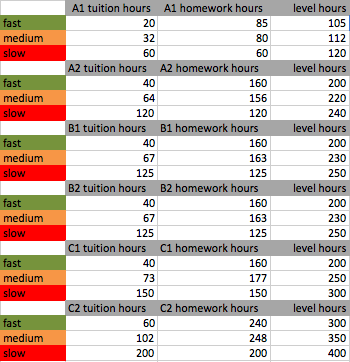
How much does a lesson cost?
PRICES
Swedish lessons for adults with a Swedish teacher
£45 per Swedish lesson per person
10 lessons for £399 (bigger packages available on request)
Swedish lessons for children and young people with a Swedish teacher
5 lessons for £199 per pupil (bigger packages available on request)
TERMS AND CONDITIONS
50 min lessons
48 hour cancellation policy
Payment in advance (when booking)
– For a full price list and bespoke offers, get in touch
Accepted payments are Paypal and most credit cards.
Apply for 1-to-1 Swedish lessons
Can I get an invoice or a receipt?
Just tell us what you would prefer!
How long will it take before I can speak decent Swedish?
Let’s start by being honest.
You will not be able to become fluent in Swedish in 1 or 2 weeks.
Anyone claiming that is possible, is simply lying.
Your language skills are not Amazon Prime!
Language learning is a long process – a bit more like a marathon than a quick sprint. It’s not like Amazon Prime; it’s not going to turn up in 24-48 hours.
Be wary of claims that you can learn a language fluently in x days/months, there are no miracle methods. If it sounds too good to be true, it probably is.
That said, you can learn quite a lot in a short space of time, especially if you also practice in between lessons.
However, it is hard to say how long it will take for someone to make a certain progress, as there are a number of factors that come in to play.
Some of them are individual learning pace in general, previous knowledge of grammar (those with much knowledge tends to progress faster), how much homework the learner is able to do between lessons (faster if more homework), and also if the learner has any particular areas that they find challenging.
The Language Levels
Quick learners can reach level A1 in about 20 tuition hours, whereas some might need 30 or more. On top of that, you’ll need another 60-70 active study hours (homework, revision, etc). But of course, you can learn a some basic conversational phrases to get by in only a few hours!
Here’s what learners are able to do for each level.
A1 - early beginner
When someone is at this level, they can understand and use familiar everyday expressions and very basic phrases aimed at the satisfaction of needs of a concrete type.
They can introduce him/herself and others and also ask and answer questions about personal details such as where he/she lives, people he/she knows and things he/she has. They are able to interact in a simple way provided the other person talks slowly and clearly and is prepared to help.
A2 - late beginner
This level means learners can understand sentences and frequently used expressions related to areas of most immediate relevance (e.g. very basic personal and family information, shopping, local geography, employment).
A2-learners can communicate in simple and routine tasks requiring a simple and direct exchange of information on familiar and routine matters. They can also describe in simple terms aspects of his/her background, immediate environment and matters in areas of immediate need.
B1 - early intermediate
This is the beginning of intermediate. Learners can understand the main points of clear standard input on familiar matters regularly encountered in work, school, leisure, etc.
They can deal with most situations likely to arise whilst travelling in an area where the language is spoken. In addition, they can produce simple connected text on topics which are familiar or of personal interest.
On a more personal note, B1-learners can describe experiences and events, dreams, hopes & ambitions and briefly give reasons and explanations for opinions and plans.
B2 - late intermediate
Now things are getting serious. B2:ers can understand the main ideas of complex text on both concrete and abstract topics, including technical discussions in his/her field of specialisation.
They can interact with a degree of fluency and spontaneity that makes regular interaction with native speakers quite possible without strain for either party. This is actually what you might call ‘fluent’.
Learners at this level can also produce clear, detailed text on a wide range of subjects and explain a viewpoint on a topical issue giving the advantages and disadvantages of various options.
C1 - early advanced
Here’s the beginning of advanced. Learners can understand a wide range of demanding, longer clauses, and recognise implicit meaning.
They can express ideas fluently and spontaneously without much obvious searching for expressions.
Also, they can use language flexibly and effectively for social, academic and professional purposes.
In addition, they can produce clear, well-structured, detailed text on complex subjects, showing controlled use of organisational patterns, connectors and cohesive devices.
Hours per level guide
How can I learn Swedish with you?
You can do a course. Click here to see all courses available.
You can also do one-to-one lessons. Click here to learn more.
What is your teaching schedule?
We teach Mondays to Fridays, mornings, daytime and some evenings (UK time).
Anneli is currently teaching Mondays, Tuesdays and Wednesday mornings only.
I don't know what my current level of Swedish is!
No problem, you can do a test here that will give you a good idea of your current level.
What is your teaching experience and background?
We have extensive teaching experience. Have a look at our backgrounds here.
What can I expect from a lesson?
A lesson usually looks like this:
*Brief improvised conversation
*Going through previous homework
*Working together with the course material, or any questions you might have
*New homework for next lesson being given
You will need to send your homework back to your teacher before the next lesson.
We also offer conversational practice sessions and pronunciation training, which do not follow the above structure.
You can read what some of the previous students have said here.
Hur funkar det med lektioner för barn?
Daniel erbjuder lektioner i svenska för barn och ungdomar. Han har undervisat på högstadienivå i Storbritannien i sju år och på låg- och mellanstadienivå i fyra år, samt 8 år online med Swedish Made Easy. Han har erfarenhet av att hjälpa barn i olika åldrar och på olika nivåer, och har även arbetat med barn som har inlärningssvårigheter.
“Jag varvar läsning med talträning men skräddarsyr lektionerna efter vad barnet behöver för att gå vidare, och utifrån deras förmåga. Först och främst är det viktigt att det finns en grogrund för att lära sig och det kommer med självförtroende. Därför ser jag alltid till att det finns på plats först. För de elever som har en god språkbas har jag små projekt med som tar 2-3 lektioner.”
Daniel använder kursmaterial framställt i Sverige, kombinerat med eget beprövat material som han använt i sin undervisning i många år, och följer svensk kursplan för utlandsboende.
Daniel skriver alltid en lektionslogg efter varje avslutad lektion som du som förälder är välkommen att läsa och ge synpunkter på. Han finns även tillgänglig via e-mail om du vill ställa frågor eller komma med förslag.
Do I need to do homework?
We recommend it, if you want to progress your Swedish. If you don’t do any homework, you need to accept that your progress will be significantly slower. This is why we always recommend getting used to doing homework after every Swedish lesson. This is the way for you to get more for your money! Interaction and contact are at a premium if you’re self-teaching, so try to stay focused to make the most out of your paid lessons.
You need to send any homework to your teacher before the next lesson. After every third chapter in the course book Rivstart (if you use that book), you will do a diagnostic test to make sure you are ready to move further.
You also need to set aside some time to revise what you have already learnt. We recommend to budget approximately 2 hours after one Swedish lesson. It’s good practice to break the revision into smaller chunks. This could for example be:
*30 min doing your homework for next lesson
*15-30 min practicing with flashcards the new words you have learnt during the lesson (Swedish Made Easy have several sets already available on Quizlet, but it’s also good to create your own)
*15-30 min practicing with flashcards words you have learnt previously
*30 min revising exercises you have done previously (for ex creating sentences using old vocabulary, recording your voice when you speak)
What kind of material do you use? Do I need to get books?
Yes. If you are a beginner or intermediate, then you will most likely need to get hold of text and exercise books. We currently use the course books Rivstart, Form i fokus and Teach Yourself Complete Swedish.
Contact us if you would like to discuss which course books will best suit your needs.
Or why not take a test to check your level?
Can I do anything to prepare for my lesson?
Yes, you can!
- Get the free Swedish Learner Toolkit
- Do your homework
- Research any vocabulary that you would like to talk about during the improvised conversation
- Note down any questions or difficulties that have arisen from your homework or other self-practice, and ask us during the lesson
- Make sure that your internet/wifi is quick enough and any IT equipment is working (headphones, computers, iPads, etc). Ideally have a Plan B if something stops working.
- Make sure you are in a space where you can concentrate. It’s ok to sit in a space where there are others around, but please make sure they don’t interrupt the session!
Can I share a lesson with someone (my partner or friend for example)
Yes you can! If you and your partner/friend wanted to do lessons together as a couple, you will get a third off the price per person. Contact us to arrange this.
I have more questions
E-mail us swedishmadeeasy (at) gmail.com. We are very happy to have a brief Zoom session before you apply/buy, if you want to discuss more or have specific questions.

hei
so if i understand right , to reach level a2 it takes about , say for fast learner ,about 200 hours of level and it says for b1 200. does that mean 200 more hours after a2 ?
Hej! Yes, that’s correct. Each level is separate in these calculations (it’s not accumulative).